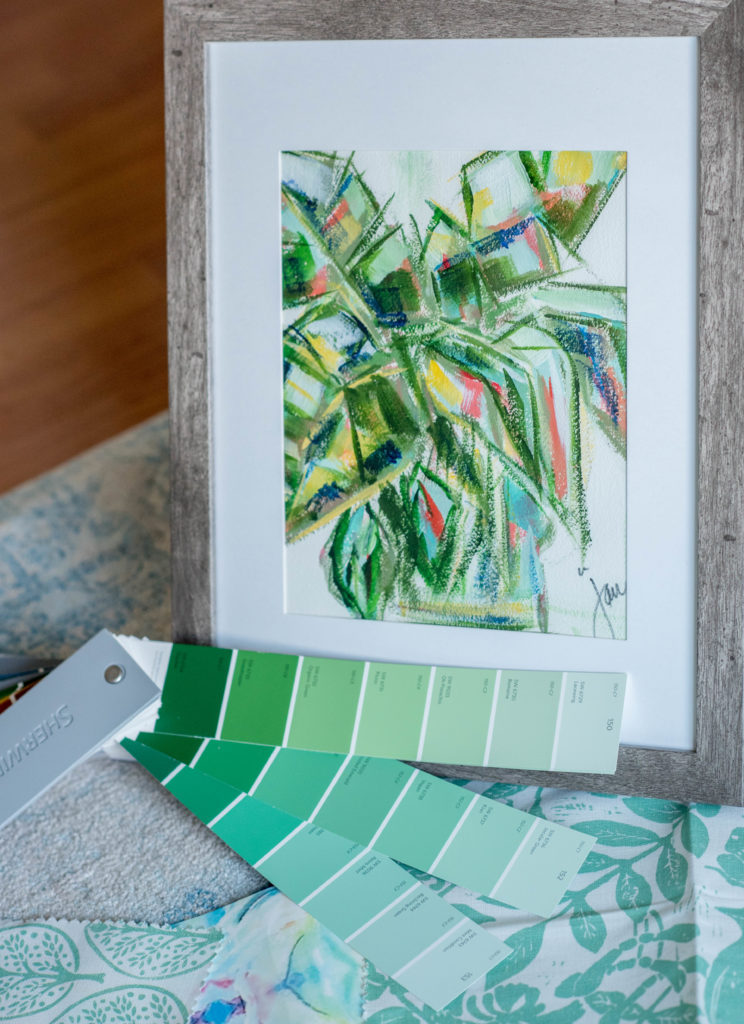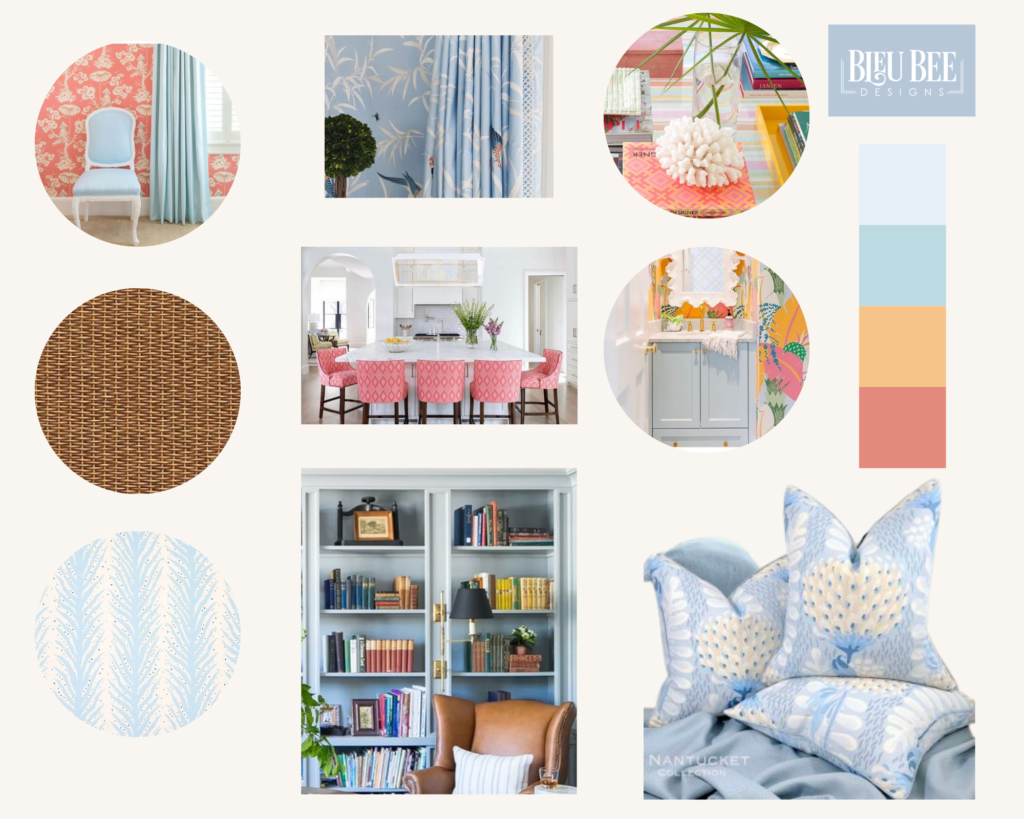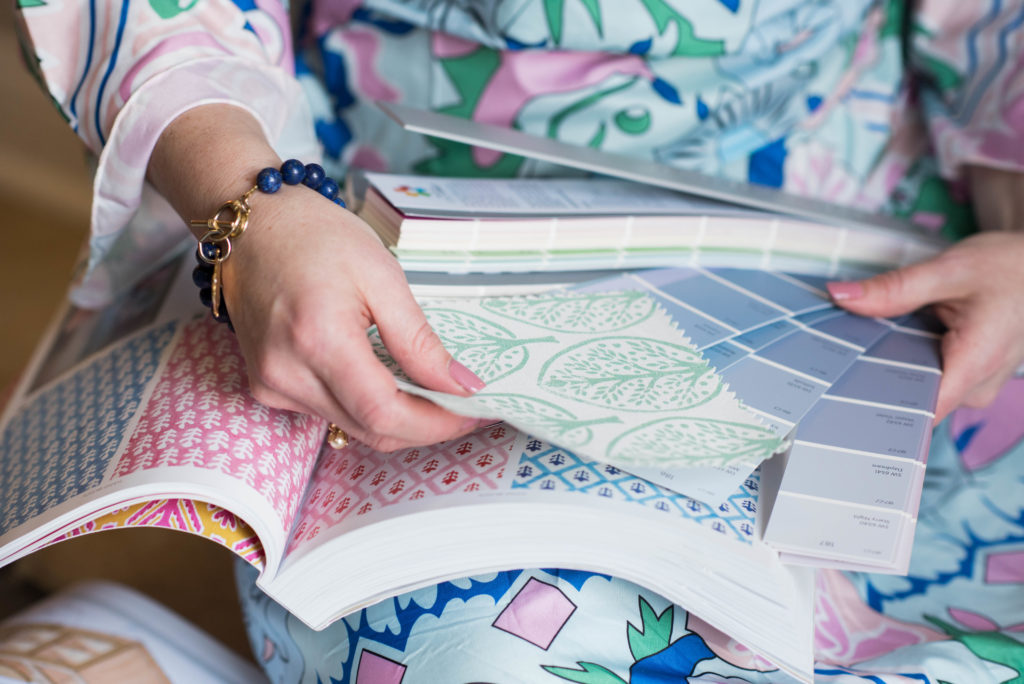Paint is always touted as “the biggest impact you can make in a room for the least amount of time and money”. As a homeowner now and previous renter, I can absolutely agree that yes, paint can make a big difference in the way a room looks and feels for little more than $50-75.

Image owned by Bleu Bee Designs.
As a designer though, this phrase often makes me cringe because it really is not that simple.
Picking the colors you love is the easy part. But picking colors that work within your home’s parameters, is another story.
I recently asked my Instagram friends for some of their top design dilemmas, and the feedback I received was enough to make 10 blog posts, so if you’re not usually a blog reader, you might want to come back regularly and get the answers to those most common design dilemmas, and hopefully you’ll find your own question answered here.
I won’t pretend to be a stellar creative writer here, but I will share my expertise and experience, which is why people hire designers in the first place. It truly is a full time job to learn about the most minute details of interior design and decor, and while I understand the general population doesn’t have time to dig into the nitty gritty of one measly little project, I do and I want to share that wisdom here with you!
So let’s talk about paint and creating a whole home color story. A color story is just like a palette, but since I believe your home is a true reflection of you and the things you love, a story is more personal, which you’ll find lots of personal elements go into choosing the colors you surround yourself with. Creating a whole home paint story has several benefits:
- Your rooms flow together cohesively and you won’t second guess your decisions
- You can easily update decor, furnishings and fabric with a set color story
- You can select paint colors with confidence after our 10-step process
- You’ll save money, time and frustration since this takes the guesswork out of finding products that feel cohesive to your home
Sounds great, right? Who doesn’t want to save 3 trips to the paint store in one day, or spend time running back and forth to Homegoods because you “swore that was the right color throw pillow for the living room”. Taking a little time to prepare your color story will save you tons of headaches in the end.
So there’s’ plenty to be gained from creating a whole home paint story, but how do you even go about getting to that point? Well, we don’t get anywhere in life without goals, so the goals below are more like boxes to check off when you’re working through our 10-step process.
Limit yourself to 5 paint colors in your color story (decision fatigue is real!)
Incorporate shades of your Go-To Color in each room
Adjacent rooms should share at least 2 colors, allowing them to feel similar in flow
Vary the intensity of your color choices
Designers love to “mix”, so balance warm and cool colors in the same room
Select a default neutral color and incorporate it in each room
Brittany zimmerman
Bleu Bee Designs

Board created by Bleu Bee Designs.
I’m a person who LOVES lists, so having a checklist for each room might be a great way to start this project. I’m also a person who LOVES color and I often pull inspiration for a project from a fabric or piece of art that inspires me (and speaks to my clients), so there are a couple of ways to get started on this color selection process.
Now, I know I’ve mentioned 10 steps, and for some of you, that seems downright daunting and you’re done reading this. But hang with me, I promise it’s not as scary as it sounds. And if you’re simply terrified at the thought of completing the 10 step process, go ahead and get in touch with us now to schedule a paint consultation and we’ll handle all the work with your feedback.
I know plenty of people who are creative enough to continue, so let’s dive in. Today I’ll cover steps 1-4, because baby steps equal big gains too.
Step 1: Pick a color family that you’re drawn to
Color families include blue, green, red, yellow, orange and purple. Think in terms of the main color you’re drawn to, and know that these color families will dwindle down into the actual shades of color you’ll use in your color story

Image: Bleu Bee Designs
Step 2: Decide the feeling, emotion or overall mood you want your home to evoke in yourself and visitors
This is pretty simple color theory in practice. Warm colors (from the color families of red, orange and yellow) will re-energize you, make a room feel physically warm and enveloping.
Cool colors (from the color families of blue, green and purple) will de-stress you, make a room feel light and relaxing.
Step 3: Determine the “fixed elements” in your home and the undertones in each
Undertones can be simply described as the subdued color, that may be modifying the actual color you’re seeing.
“Fixed Elements” are the things in your home that you aren’t changing such as trim, crown molding, wainscoting, ceiling color, flooring, countertops, etc.
Please note at this point, if you are changing any of your fixed elements, you need to have samples of the new elements on hand to determine the undertones.
Since I love lists, I would make a list of “Warm” and “Cool” undertones, and move from room to room listing the fixed elements under each undertone category.
When you’ve completed that step and know what is the most common undertone in your fixed elements, make the designer move to decide if you want to complement those undertones or contrast with them in your color story. As a designer, I am most drawn to contrasting fixed elements with paint because it creates a layer of thoughtfulness and depth to your home. Take that advice if you want!
Step 4: Select 1 (one) Go-To Color that will make an appearance in each room
Your Go-To Color may be easily your “favorite” color, one that appears the most in your clothing or other home décor choices. This Go-To Color will make itself seen in each room of your home throughout your color story, whether in full wall color, upholstery, furnishings or decorative accents. This is the color you never seem to tire of!
There you have it, 4 simple steps to take to begin working towards your dream home!
Now, if steps 1-4 seem do-able on your own, that’s fabulous and I believe in you! If you get to the end of step 4 and decide “Okay Brittany, that was a lot of work and I don’t really have the time / confidence / energy to continue with 6 more steps but I need a whole home color story” then you can contact us to create your whole home color story based on your fixed element homework and Go-To Color.
If you’re not even the tiniest bit phased by steps 1-4, then hang on to your hats because we’re about to get into the “designer details” on our next post, which walks you through selecting the remainder of your colors, including neutrals and accent colors, as well as tips & tricks for making the best paint choices for your home.
I hope you’ve enjoyed Part 1 of Creating Your Whole Home Paint Story! Check back with us for Part 2, or get notified in your inbox when a new post has dropped by signing up for our newsletter .
Creatively,

Bee
Be the first to comment